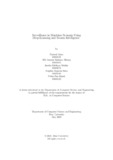Surveillance in Maritime Scenario using Deep-Learning and Swarm Intelligence
Date
2022-05Publisher
Brac UniversityAuthor
Islam, NazmulRahman Bhuiya, MD. Samiur
Drishty, Ayesha Siddiqua
Saha, Snigdha Suparna
Akash, Utsha Das
Metadata
Show full item recordAbstract
Unmanned Aerial Vehicles (UAVs) have played a crucial role in supporting Search
and Rescue (SAR) Operations due to their fast movement capabilities and flexibil ity. During a search and rescue operation scenario, the time constraint is a crucial
parameter, so the required time to detect humans in distress with precision is also
a vital part. Modern Deep-learning algorithms like CNN also aid in these missions.
However, most models and datasets available focus on search and rescue missions
on the ground or land. UAV-based search and rescue operations in the Maritime
Scenario remain a challenge. This study focused on using deep learning algorithms
such as CNN to precisely detect a human in peril with a swarm of drones. At
the same time, we emphasize using swarm intelligence algorithms such as Particle
Swarm Algorithm (PSO) to effectively find a victim in the shortest time by ex ploring a massive area. The distinctiveness of this system is that it combines the
model with the best Accuracy to detect and the best swarm intelligence algorithm
for finding targets in the quickest time possible, thus enhancing the surveillance
mission. In this research, among VGG16, ResNet50V2, InceptionV3, Xception and
MobileNetv2 models, VGG16 produced IoU (Intersection over Union) score of 0.62
with Class Label accuracy of 99.15% and Bounding Box accuracy of 88.74% in CNN
part. Along with that, among three different swarm intelligence algorithms, accord ing to the simulation, Particle Swarm Optimization Algorithm took the minimum
average time which is 20.4 units, whereas the Grey Wolf Optimization algorithm
and Bat Optimization Algorithm, respectively took 65.6 and 73.8 unit of time.

